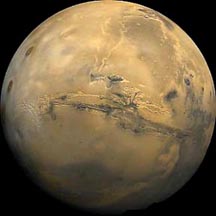
March 5, 2004 Pasadena, California - When the Opportunity rover's rock abrasion tool (RAT) drilled a hole in a piece of Martian bedrock called "McKittrick" in late February, NASA/JPL scientists were surprised that the sulfur content jumped up four times higher than the amount registered on the surface of the rock. When the rover moved over to another piece of bedrock called "Guadalupe," the sulfur amount jumped up to five times more than measured in the soil. At this week's NASA press conference in Washington, D. C., respected geochemist, Benton C. Clark, member of the Mars Explorer Rover (MER) science team and Chief Scientist of Space Exploration at Lockheed Martin said, "This supposed rock now looks like it is a chemical sediment." Sedimentation of high concentrations of sulfur and sulfate salts on earth means solution in water, the water evaporated, and left the salts.
Click here to subscribe and get instant access to read this report.
Click here to check your existing subscription status.
Existing members, login below:
© 1998 - 2025 by Linda Moulton Howe.
All Rights Reserved.

